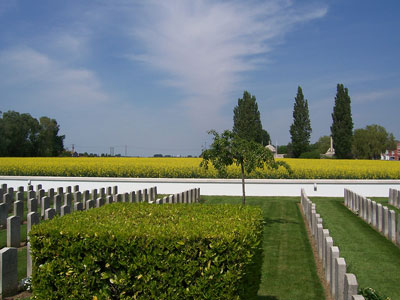
WWII: Maginot Line | Normandy | V-Weapon Sites | Arnhem
Further afield: Crete
| Home Tracing Military Ancestors Travel Advice CWGC Cemeteries Iron Harvest News Book Reviews Glossary Links Contact Me Artois:
 
|
Location 3 – The Neuve Chapelle Indian Memorial / The Portuguese Cemetery and Memorial
Directions – Continue along the D141 and turn right into Aubers village. Continue through the village and turn right at signs to Fauquissart. As you descend the slope you are again leaving the German support lines, with the front lines and no man's land being crossed just short of Fauquissart village On entering this village turn left onto the D171 towards Neuve Chapelle. Continue through the village until you reach the crowned-column of the Neuve Chapelle Indian Memorial the other side of the roundabout that sits astride the D947 from Estaires to La Bassée. The Portuguese Cemetery and Memorial are a hundred or so yards down the D947 in the direction of La Bassée. Practical Information – The D947 is very busy and cars travel very fast on the straight stretch to La Bassée. Best advice is to park up to see the Neuve Chapelle Memorial first and then drive to the Portuguese Cemetery and Memorial – be very careful when manoeuvring the car! Getting Your Bearings – This area was at the southern end of the British line during the Battle of Neuve Chapelle in March 1915. The photograph below was taken from within the Portuguese Cemetery looking towards the Indian Memorial. The British front line ran roughly in front of the wall of the Indian Memorial where the three tall trees are, whilst the German front line was in the field beyond the wall of the Portuguese Cemetery.
Neuve Chapelle Indian Memorial (photos 1-4 below) – Designed by Sir Herbert Baker, the memorial commemorates the names of 4,843 soldiers from the Indian sub-continent who have no known grave. Its position here is appropriated by the major role that the Indian Corps played in the Battle of Neuve Chapelle. Sent to Western Europe to fill the gap before Kitchener's volunteer divisions were ready for battle, the Indian Corps consisted of two divisions, the Lahore and Meerut, each of nine Indian battalions and three British. They lost 20% of their fighting strength during the March 1915 battle. The memorial is decorated with motifs and designs from the sub-continent to make this a quite unique monument.
The Portuguese Cemetery and Memorial (photos 5-7 above) – As Great Britain's oldest ally, Portugal sent two divisions to the Western Front to stand shoulder to shoulder with the Tommies. Unfortunately, however, the Portuguese proved to be ill-equipped, poorly-trained and unmotivated. When the German Army launched Operation Georgette in this sector, their second major offensive in the spring of 1918, the Portuguese division collapsed and the Germans advanced three and a half miles, rupturing the British front. After the war, this site was chosen as a concentration point for Portuguese burials on the Western Front. The cemetery contains 1,831 burials with 239 unknowns. Opposite is a small chapel built by local Portuguese nationals during the 1970's. Historical Notes – The Battle of Neuve Chapelle launched on 10th March 1915, was, largely, a politically motivated offensive aimed at proving to the French that the British were committed to the war. It was initially successful with a short 30-minute hurricane bombardment taking the Germans by surprise and a 4,000-yard slice of France being taken to a depth of 1,200 yards in places. However, due to lack of artillery ammunition and rapid movement of German reserves, the offensive was called off after three days at the cost of 13,000 officers and men. The Germans lost 12,000. The Garhwal Brigade of the Meerut Division attacked this particular sector - the British line running parallel with the D947 about a kilometre in the direction of Estaires before turning to the north-east around Neuve Chapelle village. The 2nd Leicesters were attacking the other side of the roundabout, with the 1/39th Garhwal Rifles going over the top from the trenches near the Indian Memorial. Unfortunately, however, rather than attacking towards the Bois de Biez about a kilometre to the west across prepared ground, they advanced south-east towards where the Portuguese Cemetery now stands and against a portion of the German defences not subject to the bombardment. Caught in front of the wire by concentrated rifle and machine-gun fire they suffered heavy casualties. |
|||||||

